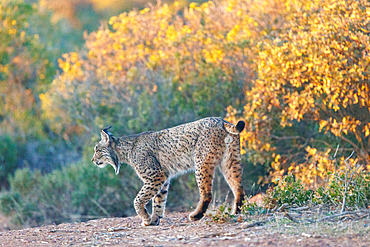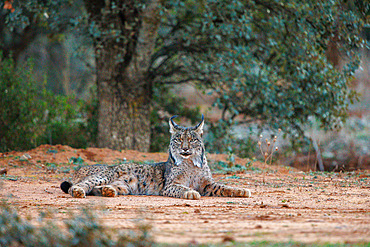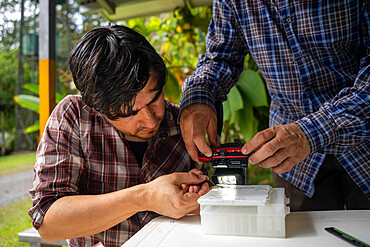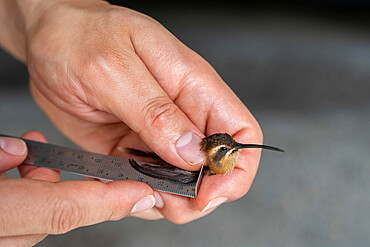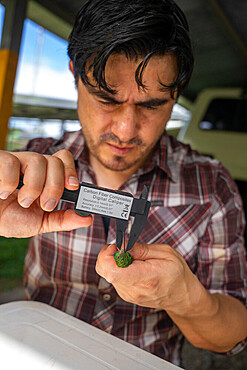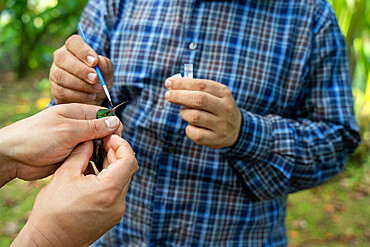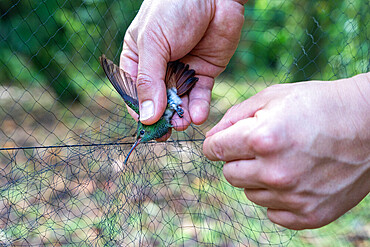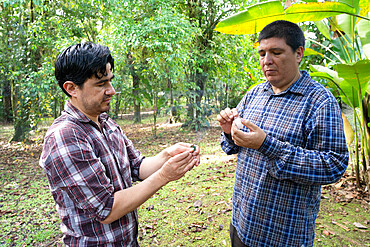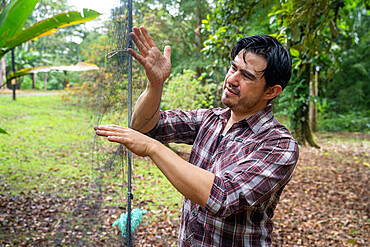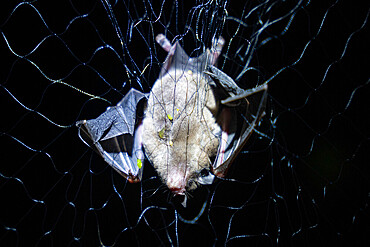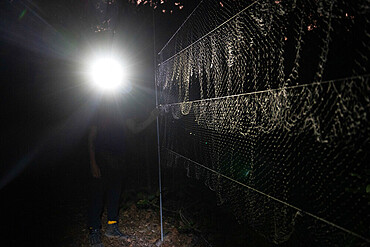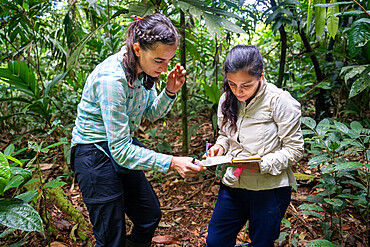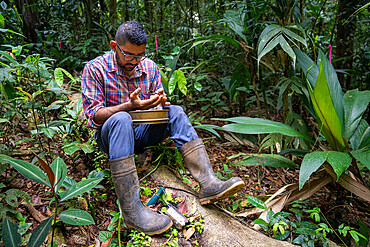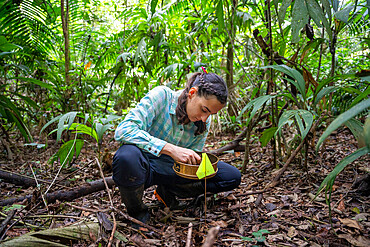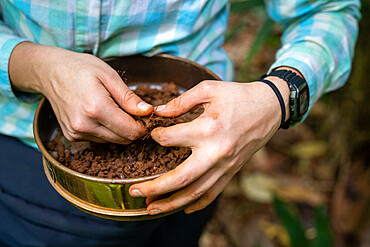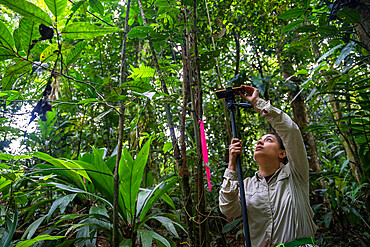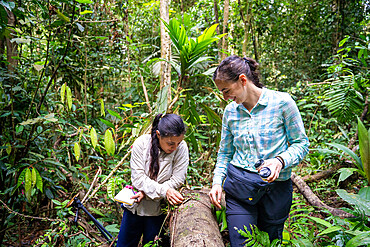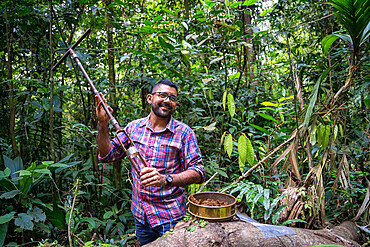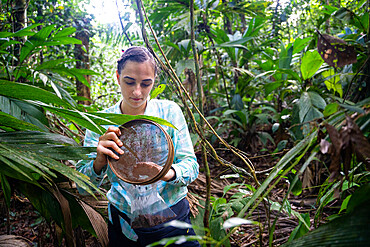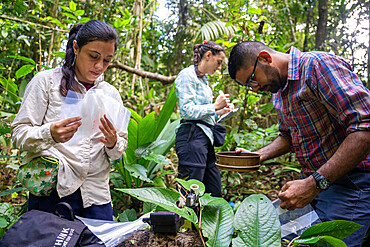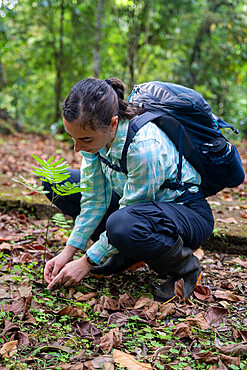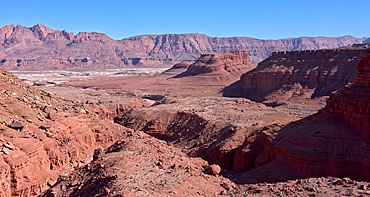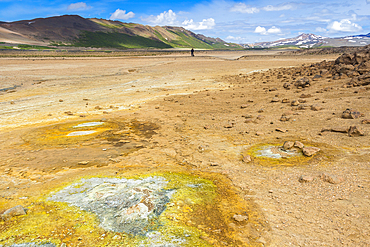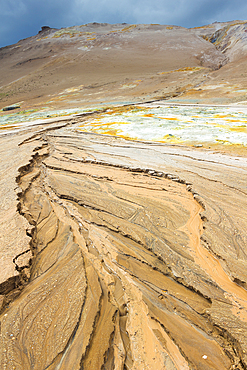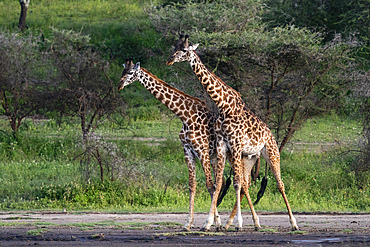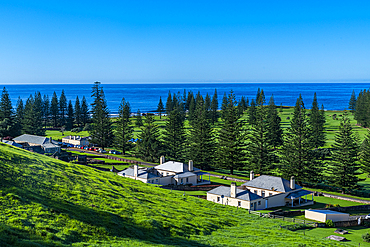Recent searches
Loading...
860-291536 - Iberian Lynx (Lynx pardinus) walking, Finca de Penalajo, Private property supporting the protection of the lynx, Castilla, Spain
860-291534 - Iberian Lynx (Lynx pardinus) walking, Finca de Penalajo, Private property supporting the protection of the lynx, Castilla, Spain
860-291533 - Iberian Lynx (Lynx pardinus) at rest, Finca de Penalajo, Private property supporting the protection of the lynx, Castilla, Spain
860-291491 - Impala or rooibok (Aepyceros melampus) herd feeding under nashatu or nyala (Xanthocercis zambesiaca) trees Mashatu, Northern Tuli Game Reserve. Botswana
860-291463 - Hemp field for CBD (cannabidiol) production 15 days before the harvest of the hemp heads, Montagny, France.
860-291464 - CBD (cannabidiol) producer or cannabiculturist in his field showing two leaves of Sativa hemp with different shapes, Montagny, France.
860-291462 - CBD (cannabidiol) producer or cannabiculturist monitoring with a specific magnifying glass the development of trichomes before harvesting hemp heads, Montagny, France
860-291461 - CBD (cannabidiol) producer or cannabiculturist monitoring with a specific magnifying glass the development of trichomes before harvesting hemp heads, Montagny, France
860-291442 - Researcher photographing a 2.6 gram Stripe-throated Hermit hummingbird as part of a pollination study, rainforest at the "La Selva" research station in Puerto Viejo de Sarapiqui, Costa Rica
860-291441 - Researcher measuring a 2.6 gram Stripe-throated Hermit hummingbird wing as part of a pollination study, rainforest at the "La Selva" research station in Puerto Viejo de Sarapiqui, Costa Rica
860-291439 - Researcher measuring the beak of a Rufous-tailed hummingbird as part of a pollination study, rainforest at the "La Selva" research station in Puerto Viejo de Sarapiqui, Costa Rica
860-291440 - Researchers picking up pollen with a brush from the beak of a hummingbird Stripe-throated Hermit as part of a pollination study, rainforest at the "La Selva" research station in Puerto Viejo de Sarapiqui, Costa Rica
860-291438 - Researchers picking up pollen with a brush from the beak of a Rufous-tailed hummingbird as part of a pollination study, rainforest at the "La Selva" research station in Puerto Viejo de Sarapiqui , Costa Rica
860-291436 - Researcher catching Rufous-tailed Hummingbird (Amazilia Tzacatl) in a net set up for pollination study, rainforest at "La Selva" research station in Puerto Viejo de Sarapiqui, Costa Rica
860-291437 - Researchers picking up pollen using tape on the beak of a Rufous-tailed hummingbird as part of a pollination study, rainforest at the "La Selva" research station in Puerto Viejo de Sarapiqui, Costa Rica
860-291434 - Researcher setting up a net to capture hummingbirds as part of a pollination study, rainforest at the "La Selva" research station in Puerto Viejo de Sarapiqui, Costa Rica
860-291435 - Rufous-tailed Hummingbird (Amazilia tzacatl) in a net set up by a researcher as part of a pollination study, rainforest at the "La Selva" research station in Puerto Viejo de Sarapiqui, Costa Rica
860-291433 - Fringe-lipped Bat (Trachops cirrhosus) in the hand of a scientist as part of a pollination study, tropical forest at the "La Selva" research station in Puerto Viejo de Sarapiqui, Costa Rica
860-291432 - Bat caught in a net as part of a pollination study, rainforest at the "La Selva" research station in Puerto Viejo de Sarapiqui, Costa Rica
860-291431 - Researcher unhooking a bat caught in a net as part of a pollination study, rainforest at the "La Selva" research station in Puerto Viejo de Sarapiqui, Costa Rica
860-291426 - Sowell's short-tailed bat (Carollia sowelli) caught as part of a pollination study, rainforest at the "La Selva" research station in Puerto Viejo de Sarapiqui, Costa Rica
860-291424 - Net for catching bats as part of a pollination study, rainforest at the "La Selva" research station in Puerto Viejo de Sarapiqui, Costa Rica
860-291425 - Sowell's short-tailed bat (Carollia sowelli) caught as part of a pollination study, rainforest at the "La Selva" research station in Puerto Viejo de Sarapiqui, Costa Rica
860-291423 - Installation of a sign on a hiking trail indicating the presence of nets to capture bats as part of a pollination study, rainforest of the "La Selva" research station in Puerto Viejo de Sarapiqui, Costa Ricardo
860-291418 - 27-year-old researcher and her team working on nitrogen exchange between bacteria and the roots of legumes in the rainforest at the "La Selva" research station in Puerto Viejo de Sarapiqui, Costa Rica
860-291417 - Research assistant working on nitrogen exchanges between bacteria and the roots of legumes in the tropical forest of the "La Selva" research station in Puerto Viejo de Sarapiqui, Costa Rica
860-291415 - 27-year-old researcher working on nitrogen exchange between bacteria and the roots of legumes in the rainforest at the "La Selva" research station in Puerto Viejo de Sarapiqui, Costa Rica
860-291416 - 27-year-old researcher working on nitrogen exchange between bacteria and the roots of legumes in the rainforest at the "La Selva" research station in Puerto Viejo de Sarapiqui, Costa Rica
860-291414 - 29-year-old assistant researcher working on nitrogen exchange between bacteria and the roots of legumes in the rainforest at the "La Selva" research station in Puerto Viejo de Sarapiqui, Costa Rica
860-291413 - 27-year-old researcher working on nitrogen exchange between bacteria and the roots of legumes in the rainforest at the "La Selva" research station in Puerto Viejo de Sarapiqui, Costa Rica
860-291412 - Research assistant working on nitrogen exchanges between bacteria and the roots of legumes in the tropical forest of the "La Selva" research station in Puerto Viejo de Sarapiqui, Costa Rica
860-291409 - 27-year-old researcher working on nitrogen exchange between bacteria and the roots of legumes in the rainforest at the "La Selva" research station in Puerto Viejo de Sarapiqui, Costa Rica
860-291410 - 27-year-old researcher working on nitrogen exchange between bacteria and the roots of legumes in the rainforest at the "La Selva" research station in Puerto Viejo de Sarapiqui, Costa Rica
860-291408 - 27-year-old researcher and her team working on nitrogen exchange between bacteria and the roots of legumes in the rainforest at the "La Selva" research station in Puerto Viejo de Sarapiqui, Costa Rica
860-291407 - Researchers walking through the rainforest at the "La Selva" research station in Puerto Viejo de Sarapiqui, Costa Rica
860-291406 - 27-year-old researcher in front of the Pracaxi legume (Pentaclethra macroloba) at the "La Selva" research station in Puerto Viejo de Sarapiqui, Costa Rica
832-400393 - Wedding. Banquet. Chairs and a table for guests, decorated with candles, are served with cutlery and crockery and covered with yellow tablecloth. Waiter setting table stands on a green lawn in the backyard banquet area
1311-627 - Glen Canyon Recreation Area with, on the left, Vermillion Cliffs National Monument and Marble Canyon, viewed from an observation point along US89 south of Page, Arizona, United States of America, North America
848-2569 - Exterior of Buddha Tooth Relic Temple, Chinatown, Central Area, Singapore, Southeast Asia, Asia
848-2568 - Exterior of Buddha Tooth Relic Temple, Chinatown, Central Area, Singapore, Southeast Asia, Asia
848-2561 - Exterior of Buddha Tooth Relic Temple, Chinatown, Central Area, Singapore, Southeast Asia, Asia
848-2553 - Telok Ayer Street, Central Area, Singapore, Southeast Asia, Asia
1311-615 - View of a rock formation called Cathedral Butte at the base of the Vermilion Cliffs, Glen Canyon Recreation Area, Arizona, United States of America, North America
1311-616 - View of a rock formation called Cathedral Rock from within Chocolate Canyon, Glen Canyon Recreation Area, Arizona, United States of America, North America
1311-614 - View of Glen Canyon Recreation Area from the middle of Lees Ferry Road at Marble Canyon, Arizona, United States of America, North America
1359-347 - Wooden boardwalk leading to area of barren trees affected by fire, near Refugio Paine Grande, Torres del Paine National Park, Patagonia, Chile, South America
1359-344 - Kokorin castle, Kokorinsko Protected Landscape Area, Central Bohemia, Czech Republic (Czechia), Europe
1359-343 - Kokorin castle, Kokorinsko Protected Landscape Area, Central Bohemia, Czech Republic (Czechia), Europe
1311-608 - The Vermilion Cliffs adjacent to Glen Canyon Recreation Area viewed from the plateau at the end of Spencer Trail in Marble Canyon with Lee's Ferry on the lower left with the Colorado River, Arizona, United States of America, North America
1311-607 - The bend in the Colorado River at Lee's Ferry in Glen Canyon Recreation Area viewed from the plateau at the end of Spencer Trail at Marble Canyon in winter, Arizona, United States of America, North America
1359-379 - Geothermal area, Namafjall Hverir, Iceland, Polar Regions
1359-336 - Rock maze, Mseno, Kokorinsko Protected Landscape Area, Central Bohemia, Czech Republic (Czechia), Europe
1359-327 - Rock maze, Mseno, Kokorinsko Protected Landscape Area, Central Bohemia, Czech Republic (Czechia), Europe
1359-351 - Beaver trail (castorera) and area of beaver dams, Tierra del Fuego National Park, Patagonia, Argentina, South America
1359-393 - Geothermal area, Namafjall Hverir, Iceland, Polar Regions
1359-387 - Geothermal area, Namafjall Hverir, Iceland, Polar Regions
1359-385 - Geothermal area and mud cracks, Namafjall Hverir, Iceland, Polar Regions
1359-382 - Geothermal area, Namafjall Hverir, Iceland, Polar Regions
1359-339 - Kokorin castle, Kokorinsko Protected Landscape Area, Central Bohemia, Czech Republic (Czechia), Europe
1359-281 - Soraypampa camping area, Salkantay trek, Mollepata, The Andes, Cusco, Peru, South America
1359-277 - Camping area Llamacorral on Santa Cruz trek, Cordillera Blanca, near Caraz, Peru, South America
1359-273 - Soraypampa camping area, Salkantay trek, Mollepata, The Andes, Cusco, Peru, South America
1359-270 - Horse at Soraypampa camping area in foggy weather, Salkantay trek, Mollepata, The Andes, Cusco, Peru, South America
1311-613 - Panorama of the south side of Johnson Point from below its cliffs at Marble Canyon, Glen Canyon Recreation Area, Arizona, United States of America, North America
1311-612 - View of the south side of Johnson Point from below its cliffs at Marble Canyon, Glen Canyon Recreation Area, Arizona, United States of America, North America
1311-611 - Panorama of Marble Canyon viewed from Johnson Point below the Vermilion Cliffs, Glen Canyon Recreation Area, Arizona, United States of America, North America
1311-610 - A pool of water reflecting the summit of Johnson Point below Vermilion Cliffs, Glen Canyon Recreation Area, Arizona, United States of America, North America
1311-609 - Panorama of Marble Canyon viewed from Johnson Point below the Vermilion Cliffs, Glen Canyon Recreation Area, Arizona, United States of America, North America
1311-605 - The cattle corral of Lonely Dell Ranch, managed by the National Park Service, at Glen Canyon Recreation Area, Arizona, United States of America, North America
1311-606 - The Paria River flowing through Paria Canyon in the Glen Canyon Recreation Area, Arizona, United States of America, North America
1350-6678 - Strawberry Poison Frog (Dendrobates pumilio), adult, Bastimentos National Park, Bocas del Toro, Panama. The strawberry poison frog or strawberry poison-dart frog (Oophaga pumilio or Dendrobates pumilio) is a species of small amphibian poison dart frog found in Central America. It is common throughout its range, which extends from eastern central Nicaragua through Costa Rica and northwestern Panama. The species is often found in humid lowlands and premontane forest, but large populations are also found in disturbed areas such as plantations. The strawberry poison frog is perhaps most famous for its widespread variation in coloration, comprising approximately 15���30 color morphs, most of which are presumed to be true-breeding. O. pumilio, while not the most poisonous of the dendrobatids, is the most toxic member of its genus. The species is most diverse in Panama with varieties in vivid shades of all red, orange, blue, yellow or green, green and yellow, white with red, orange or black and spotted varieties. The most colorful mix is found in Isla Bastimentos Marine National Park though not all in one place. Colors vary by location. A beach on the north side of the island is named after the species. Two of Southern Explorations' Panama tours visit red frog habitat. Both the eight-day Panama Adventure trip and eleven-day Panama Highlights trip spend time in Isla Bastimentos Marine National Park and the former also goes to Red Frog Beach.
The red frog is not as poisonous as some of its cousins and is not a threat to humans. It subsists on a diet of ants that dine on poisonous plants, providing the red frog its protective skin toxin. Males attract females with a loud quick chirp. To hear the distinctive sound before you depart on your Panama tours, go to the University of Michigan Museum's biodiversity website (www.animaldiversity.ummz.umich.edu.) After birth, the tadpoles climb aboard the mother who deposits them in different protected areas where she retu
1311-603 - A sign along the Bright Angel Trail in Grand Canyon warning that the plants in this area are very fragile, Grand Canyon National Park, UNESCO World Heritage Site, Arizona, United States of America, North America
809-8466 - Bull standing in front of a village main house in a rural area of Northern Senegal, West Africa, Africa
1112-7160 - Snow-covered Spring Mountains National Recreation Area, Humboldt-Toiyabe National Forest, Nevada, United States of America, North America
1126-1948 - Shopping Area, Toulon, Var, Provence-Alpes-Cote d'Azur, France, Western Europe
1184-7683 - Aerial of Kingston and Arthur's Vale Historic Area, UNESCO World Heritage Site, Norfolk Island, Australia, Pacific
1184-7687 - Aerial of the Kingston and Arthur's Vale Historic Area, UNESCO World Heritage Site, Norfolk Island, Australia, Pacific
1184-7684 - Aerial of Kingston and Arthur's Vale Historic Area, UNESCO World Heritage Site, Norfolk Island, Australia, Pacific
1184-7681 - Aerial of the Kingston and Arthur's Vale Historic Area, UNESCO World Heritage Site, Norfolk Island, Australia, Pacific
1184-7685 - Aerial of Kingston and Arthur's Vale Historic Area, UNESCO World Heritage Site, Norfolk Island, Australia, Pacific
1184-7686 - Aerial of Kingston and Arthur's Vale Historic Area, UNESCO World Heritage Site, Norfolk Island, Australia, Pacific
741-6183 - Lion (Panthera leo), Ndutu Conservation Area, Serengeti, Tanzania, East Africa, Africa
741-6227 - Two Masai giraffes (Giraffa camelopardalis tippelskirchi) walking, Ndutu Conservation Area, Serengeti, Tanzania, East Africa, Africa
741-6195 - Lioness (Panthera leo), Ndutu Conservation Area, Serengeti, Tanzania, East Africa, Africa
741-6235 - Speke's Weaver (Ploceus spekei) nesting in acacia tree, Ndutu Conservation Area, Serengeti, Tanzania, East Africa, Africa
741-6200 - Egyptian goose (Alopochen aegyptiacus) with chicks, Ndutu Conservation Area, Serengeti, Tanzania, East Africa, Africa
741-6242 - Cheetah (Acinonyx jubatus), Ndutu Conservation Area, Serengeti, Tanzania, East Africa, Africa
1184-7668 - Old ruins, Kingston and Arthur's Vale Historic Area, UNESCO World Heritage Site, Norfolk Island, Australia, Pacific
741-6216 - Blue wildebeest (Connochaetes taurinus) at waterhole, Ndutu Conservation Area, Serengeti, Tanzania, East Africa, Africa
741-6185 - Lion (Panthera leo), Ndutu Conservation Area, Serengeti, Tanzania, East Africa, Africa
741-6238 - Lion (Panthera leo) up a tree, Ndutu Conservation Area, Serengeti, Tanzania, East Africa, Africa
741-6213 - Lappet faced vulture (Torgos tracheliotos), Ndutu Conservation Area, Serengeti, Tanzania, East Africa, Africa
741-6190 - Hyena (Crocuta crocuta), Ndutu Conservation Area, Serengeti, Tanzania, East Africa, Africa
1184-7670 - Old ruins, Kingston and Arthur's Vale Historic Area, UNESCO World Heritage Site, Norfolk Island, Australia, Pacific
741-6202 - Common zebras (Equus quagga), Ndutu Conservation Area, Serengeti, Tanzania, East Africa, Africa
741-6177 - Blue wildebeest (Connochaetes taurinus) and common zebras (Equus quagga) grazing, Ndutu Conservation Area, Serengeti, Tanzania, East Africa, Africa
741-6208 - Lion (Panthera leo), Ndutu Conservation Area, Serengeti, Tanzania, East Africa, Africa
1184-7666 - Kingston and Arthur's Vale Historic Area, UNESCO World Heritage Site, Norfolk Island, Australia, Pacific
1184-7665 - Old ruins, Kingston and Arthur's Vale Historic Area, UNESCO World Heritage Site, Norfolk Island, Australia, Pacific
